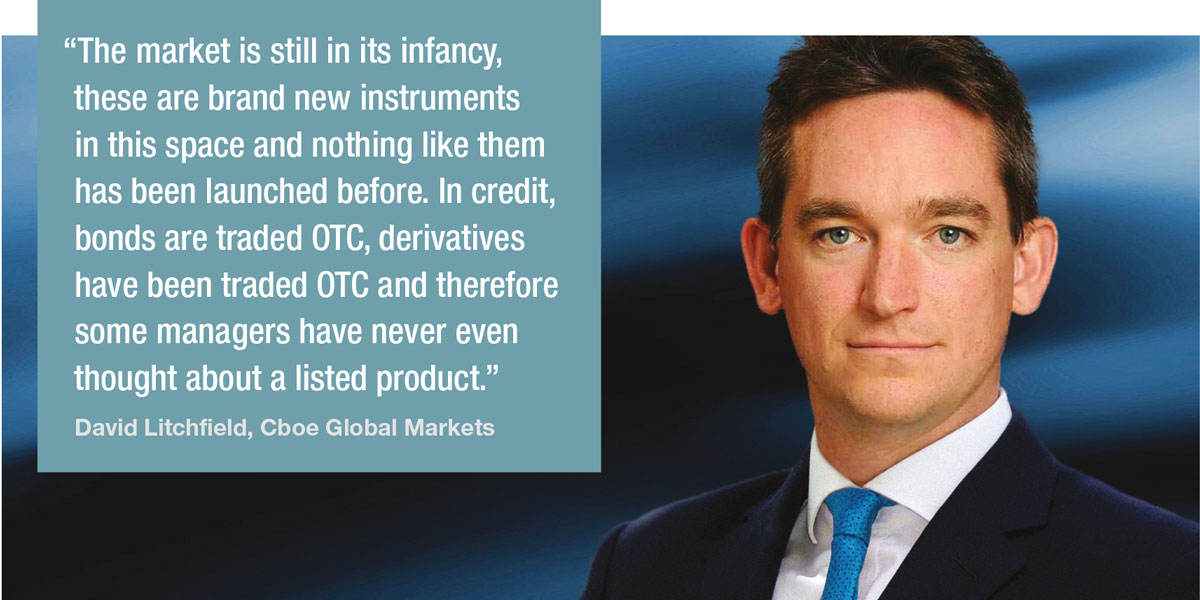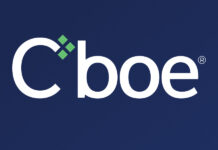David Litchfield, director for derivatives sales at Cboe Global Markets, explains how Cboe corporate bond index futures are supporting traders in a highly changeable environment.
The versatility of the Cboe iBoxx iShares Corporate Bond Index futures has been demonstrated as market circumstances changed dramatically in 2023.
With interest rates rising at a speed not seen since the 1980s, fixed income trading and investment strategists need flexibility in their approach to expressing ideas into the market.
What and how did engagement in the bond index futures market change last year?
There were two main catalysts for change last year. Firstly, the continued roll-out of Uncleared Margin Rules (UMR), with Phase 6 in September, meant more asset managers trading over-the-counter (OTC) derivatives, namely total return swaps (TRS), came into focus. That was a big catalyst.
Secondly, the rising interest rate environment made the duration risk of bond portfolios far more relevant than they had been over the last few years. Those accounts hedging bonds with credit default swap (CDS) indices are well aware of the potential basis mismatch, but that was exacerbated in a rising rates environment. That duration component is the part that has been hurting. Coupled with the UMR that really brought bond index products more into focus. Total return swaps are still traded in good volume but a number of managers now look to the futures, as they are centrally cleared with low initial margin (IM) requirements and gives index returns on the corporate bonds, as opposed to just the spread component that CDS indices give.
That demand to hedge was reflected in the shape of the futures curve. It went into backwardation quite steeply. That reflects the fact that borrowing bonds/ETFs to hedge oneself, got more expensive. If one is borrowing the ETF or underlying product for three or six months that cost is reflected in that downward sloping futures curve. So long futures holders had a good time last year by rolling their futures down from month to month.
In 2023 the environment has changed, but how is that changing the engagement you’re seeing?
The curve has gone back into contango, as we would normally expect to see it. Since the beginning of the year, a lot of allocations are going into corporate bonds, and specifically investment grade. A number of research notes have pointed to investment grade as a place to be.
The use case in terms of hedging, cash flows and liquidity with index versus credit spreads is still there, with more appetite for pure beta. Inflows coming into funds need to be put to work in beta. As new bonds are issued, or existing bonds become available the investor can diversify into those individual single names. Futures tick a lot of boxes that make them an efficient instrument to use.
What do firms need to know if they want to engage with index futures more effectively?
Think of the parallels one might draw with the equity markets. For portfolio management, there is a whole array of tools available in the equity markets including futures, options, variance swaps, dividend swaps and a whole lot more. There are fewer tools available to fixed income managers but I think that will change and these tools will be used like they are in equities. Incoming UMR rules and rising interest rates, mean efficiency and financing on one’s balance sheet is going to come into focus ever more. Therefore, an instrument like a future, which is centrally cleared and traded on a centralised trading venue is an instrument people naturally think about reaching to, rather than perhaps an OTC swap that could incur more punitive margin requirements.
Margin requirements and the other operational costs that come with OTC products, and the ease with which futures can be implemented across multiple mandates, segregated or public pools of money, is a huge attraction. Being able to apply the same investment philosophy for better hedging or tactical long allocation across all of one’s mandates is where the efficiency gains happen, rather than trying to split up different OTC instruments across only those mandates that allow it.
How is the market growth and participation changing for futures and looking ahead for options?
This futures market opens credit up to a number of participants that otherwise cannot participate in the credit market, either at all or specifically in the derivatives space. The most obvious is the CTA community. The ability for that pool of money to come into the market and facilitate flows is significant. They are not necessarily going to trade the same way, with the same rationale as the rest of the market and so could facilitate great two-way flow.
Allowing long holders, short holders, fast money and real money to express investment views which will naturally offset each other is extraordinarily healthy. Buy-side firms can be trading against buy -side, and facilitating liquidity as well as seeing support from liquidity providers.
We’re looking to launch options in early July of this year. The options infrastructure can have essentially the same people doing different things and offering extra liquidity. An example would be during a Covid-type event and everyone was selling credit, there might be managers out there looking to use options instead.
As everyone else is selling credit, if a manager is looking to buy calls to participate in the upside, then the bank selling calls to that participant will be a natural buyer of futures/ETFs/cash to hedge themselves. As everyone else is selling futures, there is a natural buyer in the market, because the options landscape has allowed that natural demand. It’s just adding to that liquidity picture by making different instruments available.
Resourcing is a real challenge for trading desks at the moment so what can they do to get access with minimal effort?
These are futures and so it’s a simple wrapper that is well understood by most: traders, PMs, Risk & Ops, etc. They look and smell like an equity future. That is, there’s no delivery of a massive basket of bonds or the ETF, they’re cash settled. Given the underlying might be deemed a new product for a mandate, a ‘new product’ process might need to be completed however, as they are futures on a centrally-cleared venue, that process is typically not very onerous. For those with UCITS mandates, S&P DJI (S&P Dow Jones Indices, formerly known as IHS Markit) has produced a document in response to all ESMA questions around what is and isn’t UCITS eligible, which is extraordinarily useful in getting that determination.
Another consideration is, if a manager raises an order to buy or sell futures, does it go down the futures execution route or to the credit desk that would trade CDS, and which desk manages it? Those are practical considerations but none of them insurmountable. We see different desks executing depending on the firm, and perhaps the portfolio manager that’s raising it.
How are you engaging with clients to support their use of futures and options?
The market is still in its infancy, these are brand new instruments in this space and nothing like them has been launched before. Education can be around what a future is and how it works; talking to risk teams and helping in the operational set up. In credit, bonds are traded OTC, derivatives have been traded OTC and therefore some managers have never even thought about a listed product. Discussing liquidity is also paramount. If an investor is comfortable buying $100 million of HYG or LQD on screen, they should be comfortable buying $100 million of the IBHY (high yield) or IBIG (investment grade) future on screen. As futures are bought and sold, the market makers behind the scenes are trading ETFs and so they are transferring that liquidity across from the ETF market.
To learn more about the product and how it trades please reach out to David Litchfield at dlitchfield@cboe.com
©Markets Media Europe 2023
©Markets Media Europe 2025













